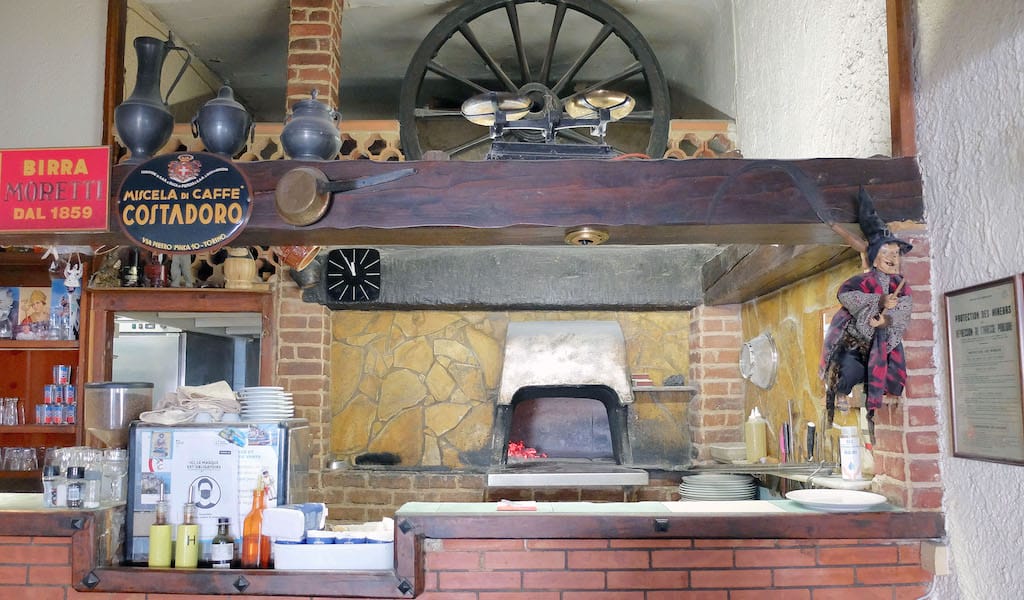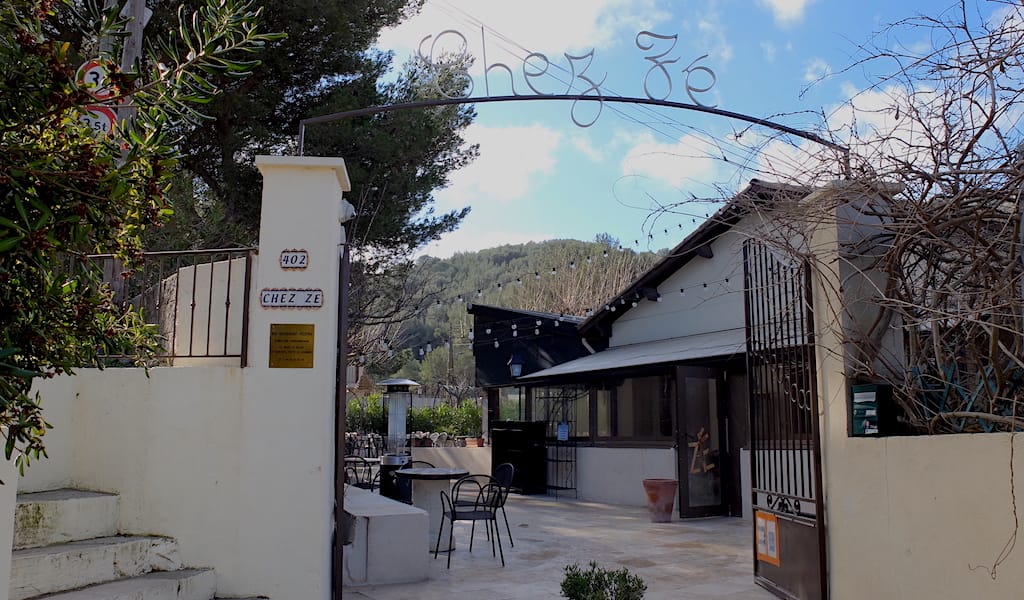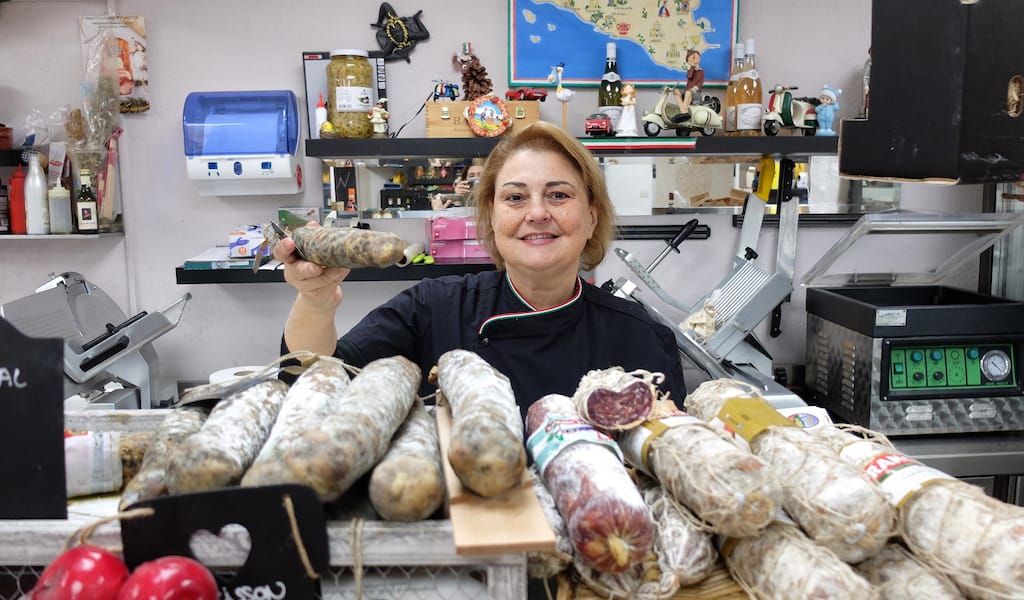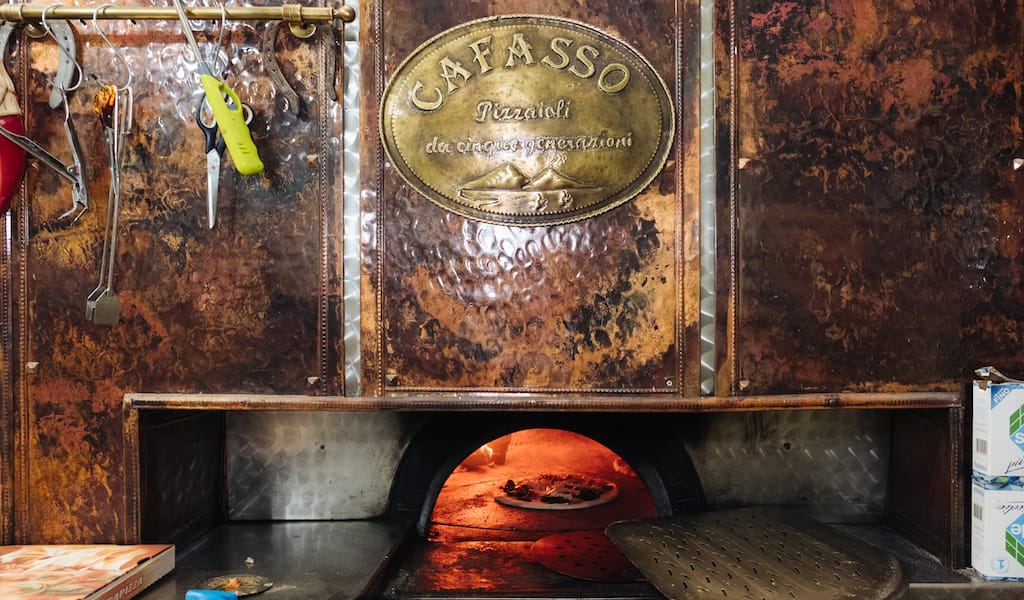“You’re going to need this,” the owner winks, handing us a steak knife to dig into our colossal calzone. When a customer wanting a quick bite orders macarronada (penne topped with meatballs, sausage and tomato sauce) he warns that it’ll take some time since “we make our pasta fresh.” Clearing the table next to us, he teases a woman for not finishing her plate, like she was family rather than a customer. Fitting for a restaurant that feels like you’re dining in an Italian home.
Tucked away on the sloping side streets of Saint-Lambert, Le Vésuvio is a slice of Italy in the heart of Marseille. For 20 years, Salvatore and Anne-Marie have dished up wood-fired pizzas and hearty pastas from their homeland. Garrulous Salvatore runs the front of the house while his more discreet wife – whom he affectionately calls “the boss” – cooks unfussy Italian classics.
Since the restaurant shares its name with the iconic volcano looming over Naples, we assumed the couple came from the southern Italian city. “No,” corrects Salvatore in his thick Italian accent, “I’m from the prettiest place in Italy,” pointing to the postcard photo on the menu. It shows Cetara, a picturesque town on the Amalfi Coast famous for tuna fishing. The sexagenarian comes from a long line of fishermen– if you’re lucky, he’ll show a photo of his tanned younger self in traditional giant nets surrounded by tuna.
But unlike his countrymen who flocked to Marseille in the 19th century, big fish isn’t what lured the couple across the Mediterranean. Anne-Marie actually grew up in Marseille, her Italian family arriving via Algeria like many pieds-noirs (Europeans who worked in Algeria during French colonial rule then returned to Europe, mainly France, after Algeria gained independence). She met Salvatore while visiting her relatives on the Amalfi Coast. When her family wanted help running a tabac in Cassis in the 1980s, the young couple came to France.
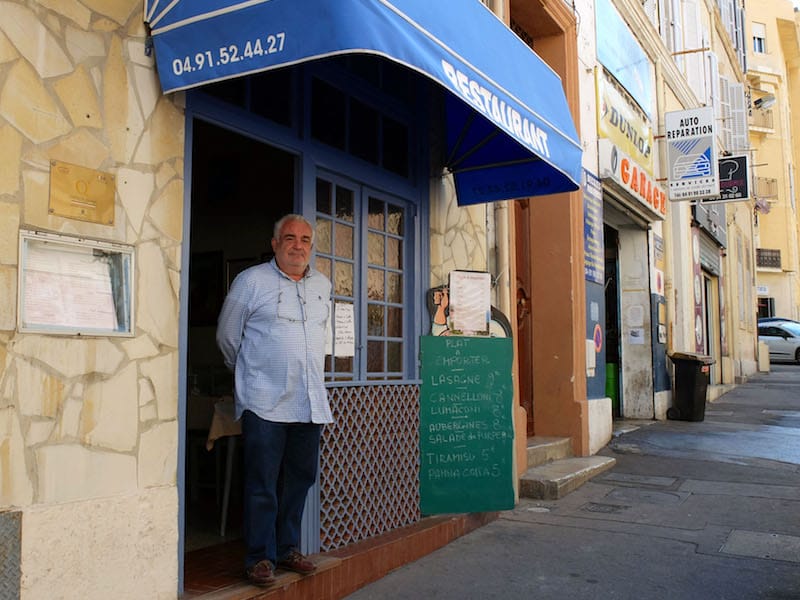
Bitten by the commercial bug, they later set up shop in Marseille’s 12th arrondissement, opening a tabac in St. Julien followed by a brasserie in Beaumont. “In those days, people lingered all day for a café, something stronger, a bite and a game of belote [cards],” reflects Salvatore. There, Anne-Marie would whip up a plat du jour – delighted to be doing what she loved the most.
“My mom had nine siblings,” shares Anne-Marie, which meant the table was always full. A passion for food was thus instilled in her at a young age, and she would fantasize about dishes she’d cook up in her own restaurant. Her dream came true when Salvatore stumbled upon Le Vésuvio. Born as a boulangerie before Second World War, the restaurant began churching out pies from their wood-fired oven during Marseille’s postwar pizza boom. But by 2000, their reputation had sunk.
Salvatore and Anne-Marie bought the place, keeping the medieval-style light fixtures and the wonderfully kitsch tiled awning above the bar. To match the vintage speckled tile floor, they painted the tables, chairs and wainscoting in sky blue – the “color of Naples,” explains Salvatore, referring to the city’s beloved football team.
Garrulous Salvatore runs the front of the house while his more discreet wife – whom he affectionately calls “the boss” – cooks unfussy Italian classics.
To add a homey touch to the simple space, the duo decorated the walls with paintings of seaside villages by Anne-Marie’s dad. Old black-and-white photos of the Vieux-Port and Le Panier quartier remind you that you’re in Marseille, while maps of Italy and a snap of Sophie Loren eating pasta bring you back to the boot – as does the witch-like doll on a broom hanging beside the pizza oven. She’s not a leftover decoration from Halloween, but a befana. The Italian version of Santa Claus was a gift from Salvatore’s mom to bring Le Vésuvio good fortune.
It definitely has blessed the pizzas. Deliciously blistered in the wood-fired oven, they taste like Napoli, thanks to their traditional sauce, made with Mutti canned tomatoes, and a fantastic crust. Made fresh each day, the dough used to make that crust is also bundled into the irresistible warm rolls that top each table. While these are true Neapolitan pizzas, they do put Gruyere on their formaggio as is done across France. Though if someone asks for a crème (white pizzas that the French love), “I’ll kick them out,” says Salvatore.
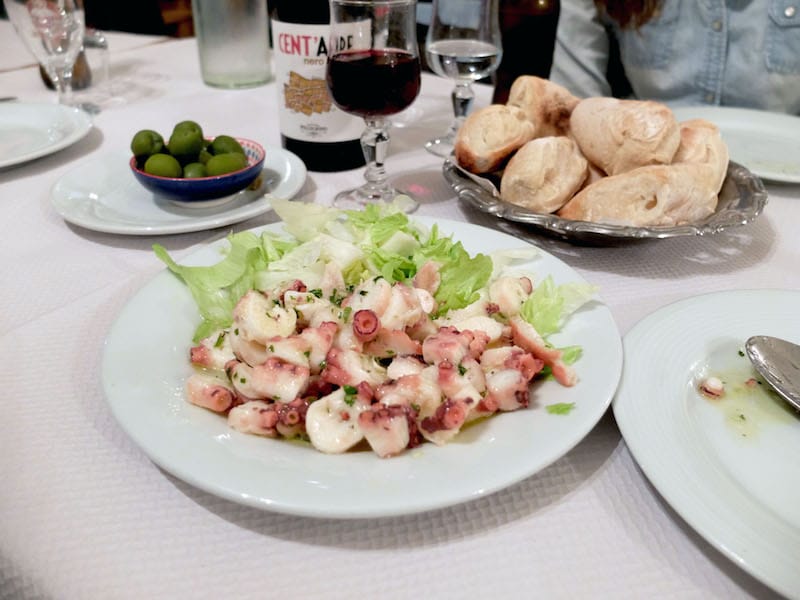
His “cousin,” a large Sicilian, mans the oven while Anne-Marie impressively helms the kitchen by herself. To start, the antipasto misto, a platter of charcuterie, ravioli fritti, grilled veggies in olive oil and glistening balls of mozzarella, is ideal for sharing. Another beloved starter is the insalata di polpi, an octopus salad simply tossed with lemon, parsley and vinegar. “It’s how the fishermen make it,” Salvatore explains. Anne-Marie adds, with a smile, “and the dish my grandparents cooked together for our wedding night.”
For pasta fans, penne con spada (pasta with swordfish), linguine alle vongole (clams), and spaghetti con calamari ripieni (stuffed calamari) pay homage to both Salvatore’s and Marseille’s seafaring roots. As does spaghetti con colatura, named for the pungent sauce of pressed anchovies that is made in Cetera. At home in anchois-loving Marseille (the small fish is the city’s preferred pizza topping), the flavorful pasta is our table’s unanimous favorite. “They’re packed with Omega-3s,” boasts Salvatore. Apparently, they also make you thirsty, for he advises us to sleep with a big glass of water by our bed.
Anne-Marie also makes the most comforting baked pastas like lasagna alla Napoletana (pumped up with hard-boiled eggs, Italian sausage and ground beef) and lumaconi, giant snail-like shells stuffed with ground beef, mozzarella, Parmesan and ricotta. The latter is on the menu thanks to Salvatore, who enjoyed eating it so much at home he wanted to share the culinary love. Diners can also order fennel-flecked sausage from Naples, steaks and lamb chops roasted in the wood fire.
According to Salvatore, the customers’ cravings depend on the day. One day it seems everyone wants pasta, while the following day the pizza oven churns out pies non-stop. “Often, it’s psychological,” he says. People choose by watching what others order, the plates parading by like a live-action version of a menu with photos.
We experienced this firsthand with the cannoli. Each time we’ve ordered the Sicilian treat, the table next to ours inquires about it. Our praise for Anne-Marie’s sweet-ricotta stuffed shells (she adds Amarena cherries and candied orange rind for good measure) inevitably leads to them ordering one. Salvatore encourages us to eat them with our hands – a rarity in knife-and-fork loving France.
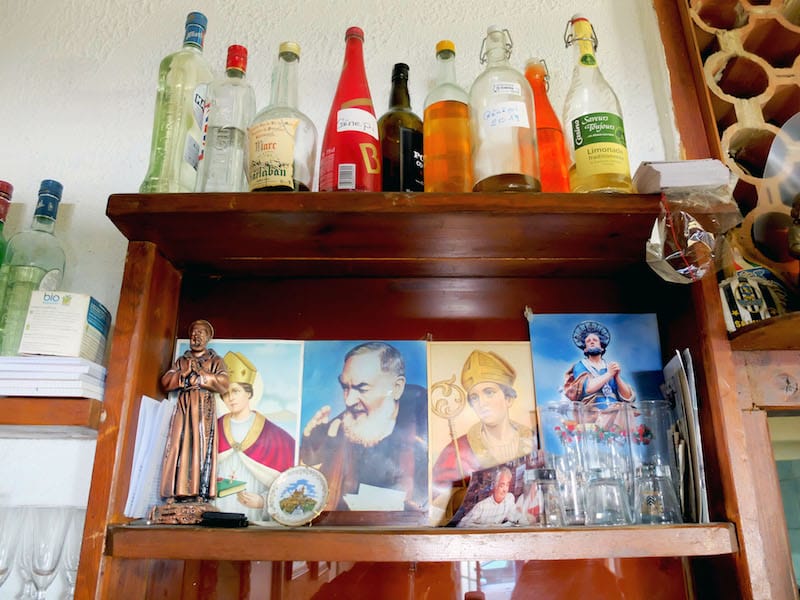
Other desserts include profiteroles drenched in oozy chocolate sauce and a sorbet citron to soothe your full stomach. Finish Italian style with the limoncello, made in house with thick-skinned Sfusato lemons. If you prefer a French digestif, then trade their citrusy elixir for herbal génépy from the Alps. During dinner, enjoy Italian beers or a bottle from the all-Italian wine list, including the Neapolitan favorite, Lacryma Christi (“Christ’s tears”).
A man of faith, Salvatore has a collection of saints: San Gennaro (patron saint of Naples), San Pietro (the patron saint of fishermen) and Padre Pio. Their photos are propped on a shelf behind the bar, across from a collage of postcards showing places across the globe. They were sent by customers to say hello from afar – just like family would do.
We first heard about Le Vésuvio from the staff at another pizzeria, the ultimate praise in the restaurant world. Word of mouth is how they roll, with regulars making up most of the clientele. By day, a mix of men in workwear and neighborhood workers stream in for lunch. At night, tables of couples, friends and families add for a more convivial ambiance. One night, we sat next to a five-top who bantered familiarly with Salvatore. While chatting with them out front post-dinner, we discovered they come every Thursday evening. A weekly ritual as treasured as Sundays with family.
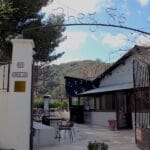 February 25, 2022 Chez Zé
February 25, 2022 Chez Zé
Mention “Les Baumettes” to a Marseillais and many immediately think of the prison that […] Posted in Marseille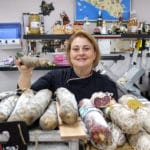 January 25, 2021 La Sicile Authentique
January 25, 2021 La Sicile Authentique
Located at the eastern edge of Marseille, Saint-Julien is a far cry from the bustling […] Posted in Marseille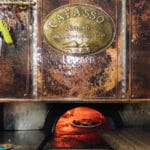 August 18, 2020 Pizzeria Cafasso
August 18, 2020 Pizzeria Cafasso
It may be on the outskirts of Naples, in the residential suburb of Fuorigrotta, but […] Posted in Naples
Published on October 27, 2020
Related stories
February 25, 2022
MarseilleMention “Les Baumettes” to a Marseillais and many immediately think of the prison that shares the name. Since the 1940s, this peripheral neighborhood has housed the city’s biggest penitentiary, where Marseille’s most notorious gangsters and French Connection collaborators did time. The prison is also infamous for France’s last execution by guillotine – shockingly recent, in…
January 25, 2021
MarseilleLocated at the eastern edge of Marseille, Saint-Julien is a far cry from the bustling city center. Here, congested boulevards stretch into narrow streets, and birdsong, not the honking of scooters, fills the air. The residential neighborhood has mostly standalone houses, from 17th-century bourgeois bastides (farmhouses) to 20th-century homes built by immigrant families searching for a…
August 18, 2020
NaplesIt may be on the outskirts of Naples, in the residential suburb of Fuorigrotta, but there’s still something about Pizzeria Cafasso that attracts clients, from famous directors to your average Joe (Giovanni, in this case). Certainly one big draw is it’s proximity to the San Paolo football stadium, one of the few things in Naples…







































